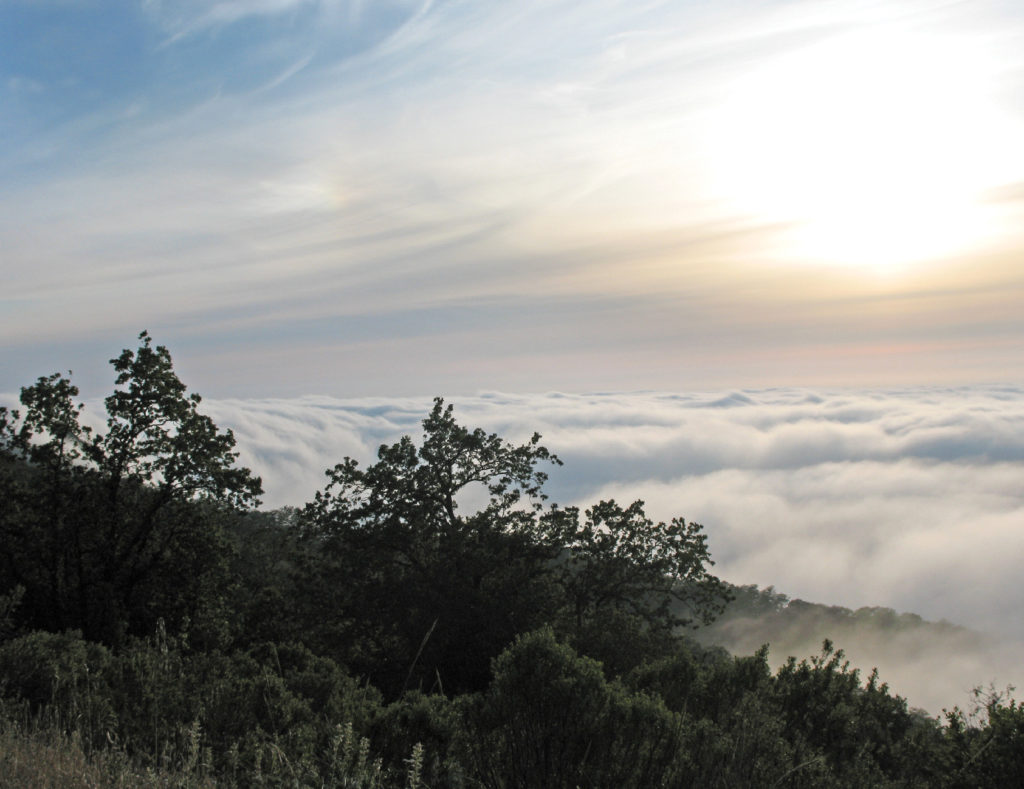 On Monterey County’s northeastern edge, where the Gabilan Mountains cross the San Benito County border, a small state park overlooks its Carmel and Monterey Peninsula neighbors. Locals might know Fremont Peak from newscasts—it’s where several broadcasters and communications providers position their towers—but the park’s remote location and unobstructed views make it a favorite for campers, wildlife watchers and stargazers, as well.
On Monterey County’s northeastern edge, where the Gabilan Mountains cross the San Benito County border, a small state park overlooks its Carmel and Monterey Peninsula neighbors. Locals might know Fremont Peak from newscasts—it’s where several broadcasters and communications providers position their towers—but the park’s remote location and unobstructed views make it a favorite for campers, wildlife watchers and stargazers, as well.
California was still under Mexican rule when military captain and coastal surveyor John C. Fremont led explorers through the Salinas Valley in 1846. When the Mexican government ordered Fremont to leave, his group climbed today’s Fremont Peak and created a makeshift fort. He raised a US flag as Mexican soldiers assembled in San Juan Bautista, but then left the summit before the conflict escalated. Fremont was later cour t-mar tialed, pardoned by President James K. Polk, and elected to the United States Senate.
Today, Fremont Peak is a registered California Historical Landmark and with two monuments detailing Fremont’s story. Fremont Peak Day, a commemoration dating back about a century, takes place each April.
“Part of what he did inspired the Bear Flag Revolt, which later made California a state,” says Derek Davis, the California State Parks ranger overseeing Fremont Peak State Park.
Measuring in at 159 mountaintop acres and approximately 3,170 feet in elevation, Fremont Peak State Park experiences more extreme weather than much of the surrounding region. Temperatures here climb above 100 in the summer. In the winter, they can drop to around 10 degrees, and snow tends to fall a few days each year. Manzanita, scrub oak and coyote brush cover the nor thern slopes, while madrone, pine and oak stands dot grasslands on the western and southern sides.
Those varied habitats house a variety of wildlife (“Just about everything short of bears,” says Davis), ranging from squirrels and deer to wild turkeys, bobcats and mountain lions. Golden eagles, great horned owls, red-tailed hawks and peregrine falcons soar above the park, as well, along with finches and hummingbirds. While the nature is a draw, it’s the view that truly distinguishes Fremont Peak State Park.
“The view is one of the best features. If you look straight to the west, you line up with the
Moss Landing towers, so you have a perfect view of the Monterey Bay all the way from Santa Cruz from Pacific Grove. On a clear day, you can see the waves breaking,” Davis says, adding that sunsets at the park are second to none.
On those clear days, visitors take in 360-degree panoramas that stretch across Santa Cruz, Santa Clara, San Benito and Monterey Counties, along with the Santa Lucia, Gabilan and Diablo Ranges. And, thanks to the park’s distance from cities and light sources, it has long been popular with professional and amateur astronomers. After telescope maker Kevin Medlock partnered with California State Parks to install his 30-inch Challenger telescope at Fremont Peak in 1986, a nonprofit formed to establish an observatory and an array of public programs that now span three decades.
“A primary element of our mission is astronomical outreach. We share with members of the public the wonders of the night sky,” says Fremont Peak Observatory Association (FPOA) president Doug Brown. “We teach people about astronomy, and what is out in the universe and where are we in it, as well some of the history and dynamics of what’s going on out there.”
More than 100 local and distantly located members suppor t FPOA, leading viewing events, astrophotography sessions and presentations for guests. Local university students also volunteer, enjoying rare technical experiences that sometimes inspire them to pursue related post-graduate degrees. FPOA celebrates its 30th annual Star-B-Que on August 15, with a potluck, silent auction, games, prizes and presentations culminating with an evening of stargazing in Fremont Peak State Park.
Community members can also attend this year’s viewing programs on several Saturday evenings between now and October. FPOA volunteers outfit telescopes with special equipment for daytime solar viewing activities once a month through October, too.
Brown says FPOA members, who include everyday astronomy enthusiasts, rocket scientists and engineers, appreciate the chance to contribute to the local community.
“This is an opportunity to help people better understand science and how it’s done, while exploring what our place is in the universe,” he says.
In addition to astronomy programs and wildlife watching opportunities, Fremont Peak State Park offers recreational hiking on about five miles of interconnected trails. The more challenging Cold Springs Trail descends more than 400 feet into a canyon, for example, while the Peak Trail opens to sweeping views on clear days. There’s also a paved service road that accommodates wheelchairs and strollers, and visitors can set up tents at 25 regular and large group campsites in the park.
Davis says Fremont Peak attracts a number of families and school groups, plus campers searching for a tranquil outdoor experience.
“I think what most of our people really appreciate, besides the view, is just the peace and quiet,” he says. “You hear the birds. You see the wildlife. You really are out there with nature.”
For directions, trail maps and information on camping in Fremont Peak State park, call 831/623-4255 or visit the California State Parks website, www.parks.ca.gov. To view a schedule of 2015 Fremont Peak Observatory Association’s public programs, visit www.fpoa.net. The 30th annual Fremont Peak Star-B-Que takes place on Saturday, August 15.